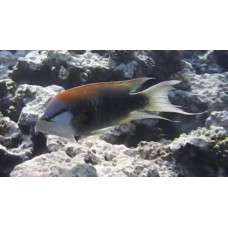Latin name
Epibulus insidiator
Other name
Epibulus insidiator
Identification
The most striking feature of the Sling-jaw Wrasse is its mouth, which is equipped with strongly protruding jaws that fold into a tube half the length of the head. Members of this species possess a unique ligament and two enlarged ligaments which, together with some changes in the shape of the cranial bones, allow them to achieve extreme jaw protrusion. The ability to extend the jaws to such extreme lengths is the result of a radical reorganisation of the jaw joint system compared to the closely related wrasse Cheilinus.
The similar species Epibulus brevis is more restricted in distribution and smaller in size, males are duller coloured, females have black pigmentation on the pectoral fins and longer pectoral fins.
Features of fish fins
The dorsal fin has 9-10 spines and 9-11 soft rays, while the anal fin has 3 spines and 8-9 soft rays.
Fish colouring
The males of this species are greyish-brown with an orange border on the back, a yellowish stripe on the flanks and a pale grey head with a thin black stripe across the eye. The body of the male is also iridescent. The scales on the male's body are edged with darker pigment. Females can be either pale yellow or dark brown, while juveniles are brown with thin white stripes on the flanks and white lines running from the eyes. There are individuals with a medium pattern that have yellow spots, a pale tail and sometimes black pectoral fins.
Distribution
Widespread throughout the Indo-Pacific region from the east coast of Africa, Madagascar and the Red Sea through the Indian Ocean coasts and islands to the Pacific Ocean as far as Johnston Atoll in Hawaii, although migratory species are also found in the main Hawaiian chain. Reaches as far north as Japan and as far south as New Caledonia. Occurs along the northern coasts of Australia from the Houtman-Abroglio Archipelago to the reefs of the Coral Sea off Queensland.
Habitat
A benthopelagic species inhabiting coral-rich areas of lagoons and inshore reefs, adults are usually found along reef slopes or near cliffs. Habitat depths range from 0 to 50m.
Size
The largest specimens can reach 54 centimetres (21 inches) in length.
Behavior
Usually solitary. Capable of drifting migration with floating leaves. The colouration of males has been observed to become more intense during courtship. During courtship, males swim with the caudal fin lowered and angled upwards, while the anal fin is folded and extended downwards. This species also changes colouration as a result of aggressive mimicry.
Food and feeding habits
The speed and length of the Sling-jaw wrasse jaws allows it to catch small fish and crustaceans.
Reproduction
This species is thought to be an ancestral hermaphrodite. Males occupy an area of 500-1000 square metres and some females appear to inhabit their territory. Spawning occurred at high tide. The pair has been observed to rise 2-3 metres during spawning. Spawning appears to be initiated by the females and has been recorded in March, April, May, July, September and October.
Fishing
This species is of secondary importance to the local commercial fishery.
Relationship with a person
Reports of ciguatera poisoning. Sling-jaw wrasse can be found in the aquarium trade.
| Classification | |
| Phylum | Chordata |
| Class | Actinopterygii |
| Squad | Actinopterygii |
| Family | Labridae |
| Genus | Epibulus |
| Species | E. insidiator |
| Features | |
| Conservation status | Least Concern |
| Habitat | Pelagic |
| Life span, years | No information |
| Maximum body weight, kg | No information |
| Maximum length, cm | 54 |
| Sailing speed, m/s | No information |
| Threat to people | Edible |
| Way of eating | Predator |
Sling-jaw wrasse
Tags: sling-jaw wrasse




